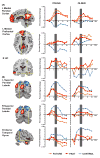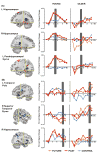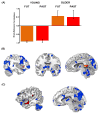Age-related neural changes in autobiographical remembering and imagining
- PMID: 21945808
- PMCID: PMC3207038
- DOI: 10.1016/j.neuropsychologia.2011.09.021
Age-related neural changes in autobiographical remembering and imagining
Abstract
Numerous neuroimaging studies have revealed that in young adults, remembering the past and imagining the future engage a common core network. Although it has been observed that older adults engage a similar network during these tasks, it is unclear whether or not they activate this network in a similar manner to young adults. Young and older participants completed two autobiographical tasks (imagining future events and recalling past events) in addition to a semantic-visuospatial control task. Spatiotemporal Partial Least Squares analyses examined whole brain patterns of activity across both the construction and elaboration of autobiographical events. These analyses revealed that that both age groups activated a similar network during the autobiographical tasks. However, some key age-related differences in the activation of this network emerged. During the construction of autobiographical events, older adults showed less activation relative to younger adults, in regions supporting episodic detail such as the medial temporal lobes and the precuneus. Later in the trial, older adults showed differential recruitment of medial and lateral temporal regions supporting the elaboration of autobiographical events, and possibly reflecting an increased role of conceptual information when older adults describe their pasts and their futures.
Copyright © 2011 Elsevier Ltd. All rights reserved.
Figures







References
-
- Abraham A, Schubotz RI, von Cramon DY. Thinking about the future versus the past in personal and non-personal contexts. Brain Research. 2008;1233:106–119. - PubMed
-
- Addis DR, McIntosh AR, Moscovitch M, Crawley AP, McAndrews MP. Characterizing spatial and temporal features of autobiographical memory retrieval networks: a partial least squares approach. Neuroimage. 2004;23:1460–1471. - PubMed
-
- Addis DR, Pan L, Vu M, Laiser N, Schacter DL. Constructive episodic simulation of the future and the past: distinct subsystems of a core brain network mediate imagining and remembering. Neuropsychologia. 2009;47:2222–2238. - PubMed
Publication types
MeSH terms
Grants and funding
LinkOut - more resources
Full Text Sources
Medical
Miscellaneous

